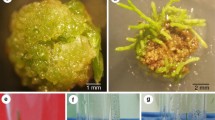Summary
Fifty-six isolates of Rhizobium and Bradyrhizobium spp. (Cajanus) were studied for their plasmid profile and N2-fixation efficacy. One to three plasmids were reproducibly detected in all the Rhizobium spp. strains but no plasmid was detected in the Bradyrhizobium spp. strains. Rhizobium sp. strain P-1 was mutagenized by Tn5 and three nod− and six nod+fix− were screened for symbiotic parameters. Neomycin-sensitive mutants were isolated by elevated temperatrue (40°C) from tranconjugants carrying Tn5 insertions. The high temperature “cured” these mutants from the single large plasmid present in the parent strain P-1. All these cured mutants were nod−, indicating that the genes for nodulation were present on this plasmid, which is readily cured at a high temperature (40°C). The high temperature in the semi-arid zones of Haryana could be responsible for the low nodulation of pigeonpea because the plasmid carrying the nodulation genes is cured at 40°–45°C giving rise to non-nodulating mutants.
Similar content being viewed by others
References
Alexander M (1982) Ecology of Rhizobium. In: Alexander M (ed) Biological nitrogen fixation ecology, technology and physiology. Plenum Press, London, pp 30–90
Banfalvi Z, Sakanyan V, Koncz A, Kiss A, Dusha I, Kondorosi A (1981) Location of nodulation and nitrogen fixation genes on a high molecular weight plasmid of R. meliloti. Mol Gen Genet 184:318–325
Cahadia E, Leyva A, Ruiz Arguiso T (1986) Indigenous plasmids and cultural characteristics of rhizobia nodulating chickpea (Cicer arietinum L.). Arch Microbiol 146:239–244
Cantrell MA, Hickok RE, Evans HJ (1982) Identification and characterisation of plasmids in hydrogen uptake positive and hydrogen uptake negative strains of Rhizobium japonicum. Arch Microbiol 131:102–106
Casse F, Boucher C, Juliot JS, Michel M, Denarie J (1979) Identification and characterisation of large plasmids in Rhizobium meliloti using gel electrophoresis. J Gen Microbiol 113:229–242
Chatel DL, Parker CA (1973) Survival of field grown rhizobia over the dry summer periods in western Australia. Soil Biol Biochem 5:415–423
Chua KY, Pankhurst CE, Macdonald PE, Hopcroft DH, Jarvis BDW, Scott WD (1985) Isolation and characterization of Tn5 induced mutants of Rhizobium loti. J Bacteriol 162:335–343
Dahiya JS, Khurana AL (1981) Chillum jar, a better technique for screening rhizobia under summer conditions. Plant and Soil 63:299–302
Denarie J, Boistard P, Casse-Dilbart F (1981) Indigenous plasmids of Rhizobium. In: Giles KL, Atherly AG (eds) Biology of Rhizobiaceae. Academic Press, London, pp 225–246
Donowa AL, Quilt P (1981) Response of pigeonpea (Cajanus cajan (L) Millsp.) to inoculation in nutrient deficient soil. Trop Agric (Trinidad) 58:307–312
Dowdle SF, Bohlool BB (1985) Predominance of fast growing R. japonicum in soybean field in the Peoples Republic of China. Appl Environ Microbiol 50:1171–1176
Eckhardt T (1976) A rapid method for the identification of plasmid DNA in bacteria. Plasmid 1:584–588
Hardy RWF, Holstein RD, Jackson EK, Burns RC (1968) The acetylene-ethylene assay for nitrogen fixation: Laboratory and field evaluation. Plant Physiol 43:1185–1207
Khurana AL, Sharma PK (1985) Field response to Rhizobium inoculations. Proc Natl Symp Current status of nitrogen fixation research. Haryana Agricultural University Press, Hisar, pp 121–124
Kingsley MT, Bohlool BB (1983) Characterization of Rhizobium (Cicer arietinum) by immunodiffusion, immunofluorescence and intrinsic antibiotic resistance markers. Can J Microbiol 29:780–782
Morrison NA, Hua CY, Trinick MJ, Shine J, Rolfe BG (1983) Heat curing of sym plasmid in a fast growing Rhizobium spp. that is able to nodulate legume and non-legume Parasponia spp. J Bacteriol 153:527–531
Munever F, Wollum AG (1981) Growth of R. japonicum strains at temperatures above 29°C. Appl Environ Microbiol 42:255–258
Nautiyal CS, Hedge SV, Burkum P Van (1988) Nodulation, nitrogen fixation and hydrogen oxidation by pigeonpea Bradyrhizobium spp. in symbiotic association with pigeonpea, cowpea and soyabean. Appl Environ Microbiol 54:94–97
Nuti MP, Lepidi AA, Prakash RK, Shilperoort RA, Cannon FC (1979) Evidence for nitrogen fixation genes on indigenous Rhizobium plasmids. Nature (London) 282:533–535
Prakash RK, Hooykaas PJJ, Ledebeor AM, Kijne JW Shilperoort RA, Nuti MP, Lepidi AA, Casse F, Bocher F, Julliot JS, Denarie J (1980) Detection, isolation and characterization of large plasmids in Rhizobium. In: Newton WE, Orme Johnson WH (eds) Nitrogen fixation, vol II, Symbiotic association and cynobacteria. University Park Press, Baltimore, Maryland, pp 139–163
Rolfe BG, Shine J (1984) Rhizobium-leguminosae symbiosis: The bacterial point of view. In: Verma DPS, Holm H (eds) Gene involved in microbe plant interaction. Springer, Vienna, pp 95–98
Rosenberg C, Boistard P, Denarie J, Casse F (1981) Genes controlling the early and late function in symbiosis are located on megaplasmid in R. meliloti. Mol Gen Genet 184:326–333
Simon R (1984) High frequency mobilization of gram negative bacterial replicon by the in vitro constructed Tn-5 mob transposon. Mol Gen Genet 196:413–420
Simon R, Priefer U, Pühler A (1983) A broad host range mobilization system for in vivo genetic engineering random and site specific mutagenesis in gram negative bacteria. Biotechnol 1:784–791
Somaseragan P, Reyes VG, Hoben HJ (1984) Influence of high temperature on the growth and survival of Rhizobium spp. in peat inoculant during preparation, storage and distribution. Can J Microbiol 30:23–30
Vincent JM (1970) A manual for practical studies of the root nodule bacteria. International biological Programme Handbook, Blackwell Scientific Publisher, Oxford, pp 7–8
Zurkowsky W, Lorciewicz Z (1978) Effective method for the isolation of non-nodulating mutants of R. trifolii. Genet Res 32:311–314
Author information
Authors and Affiliations
Rights and permissions
About this article
Cite this article
Sharma, P.K., Laxminarayana, K. Effect of high temperature on plasmid curing of Rhizobium spp. in relation to nodulation of pigeonpea [Cajanus cajan (L.) Millsp.]. Biol Fert Soils 8, 75–79 (1989). https://doi.org/10.1007/BF00260520
Received:
Issue Date:
DOI: https://doi.org/10.1007/BF00260520




